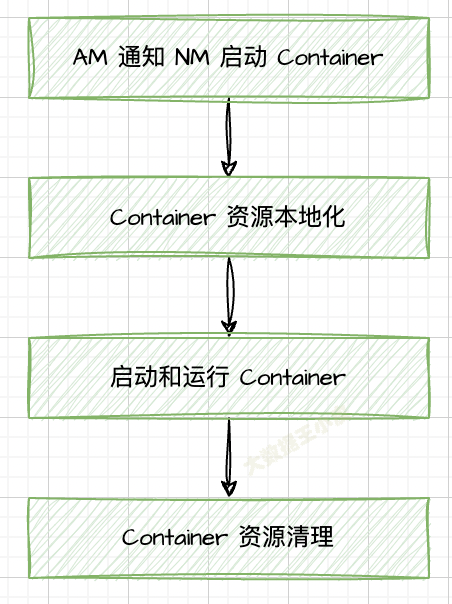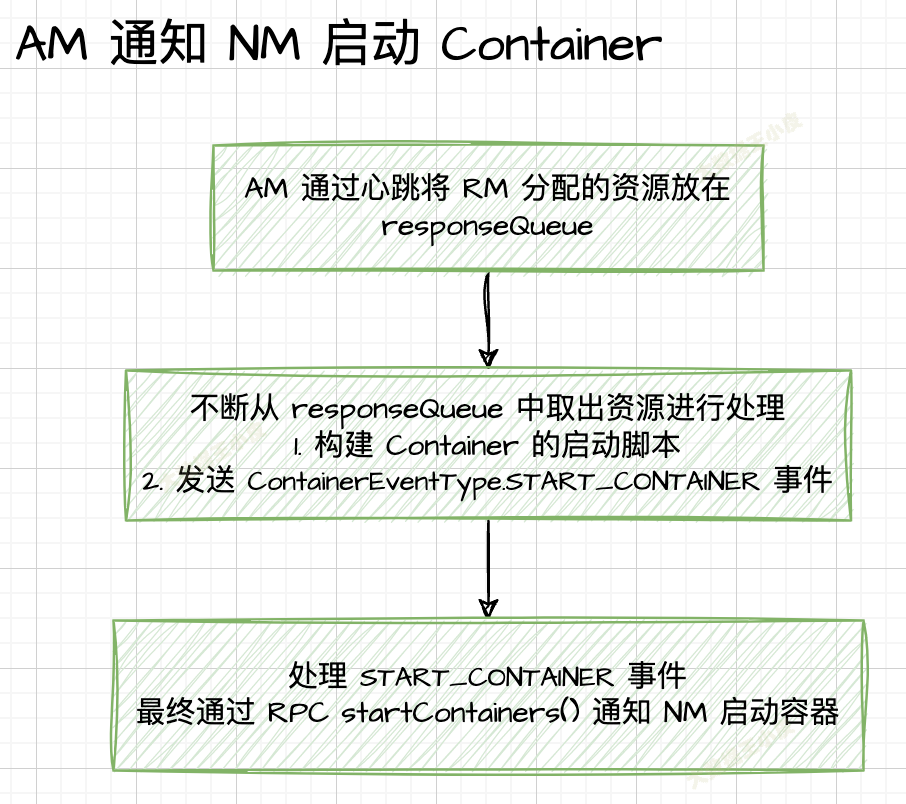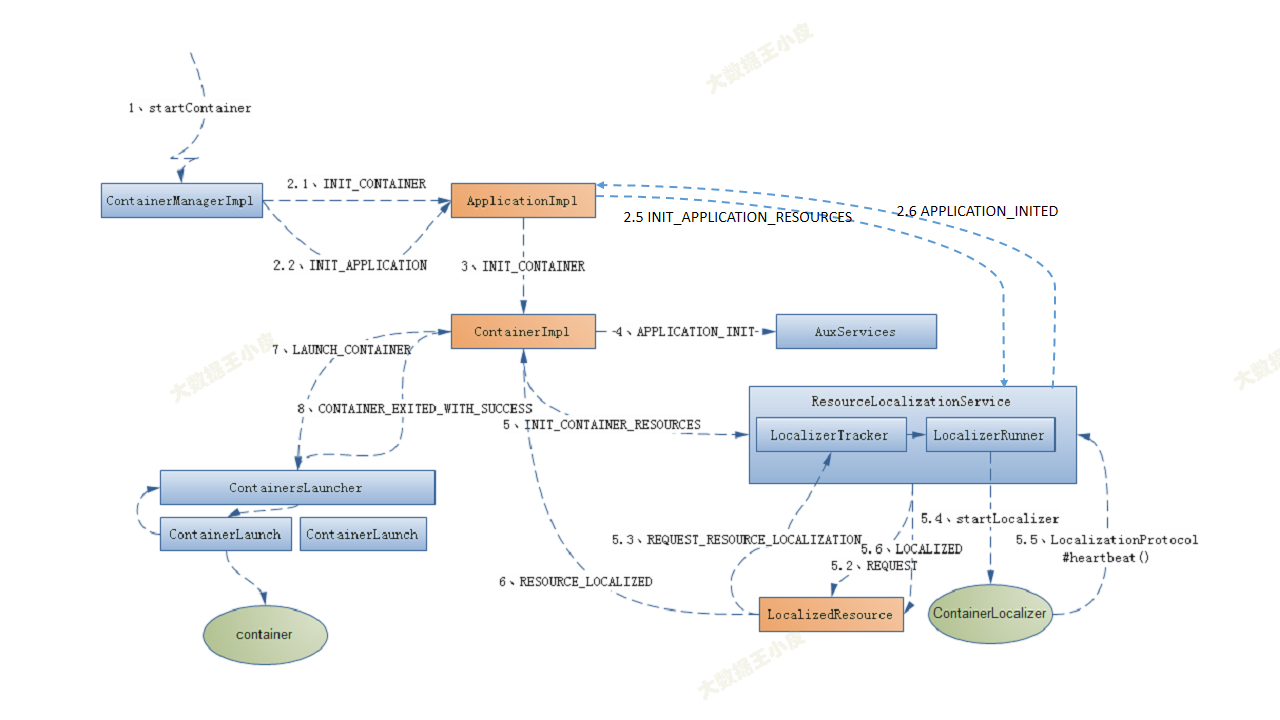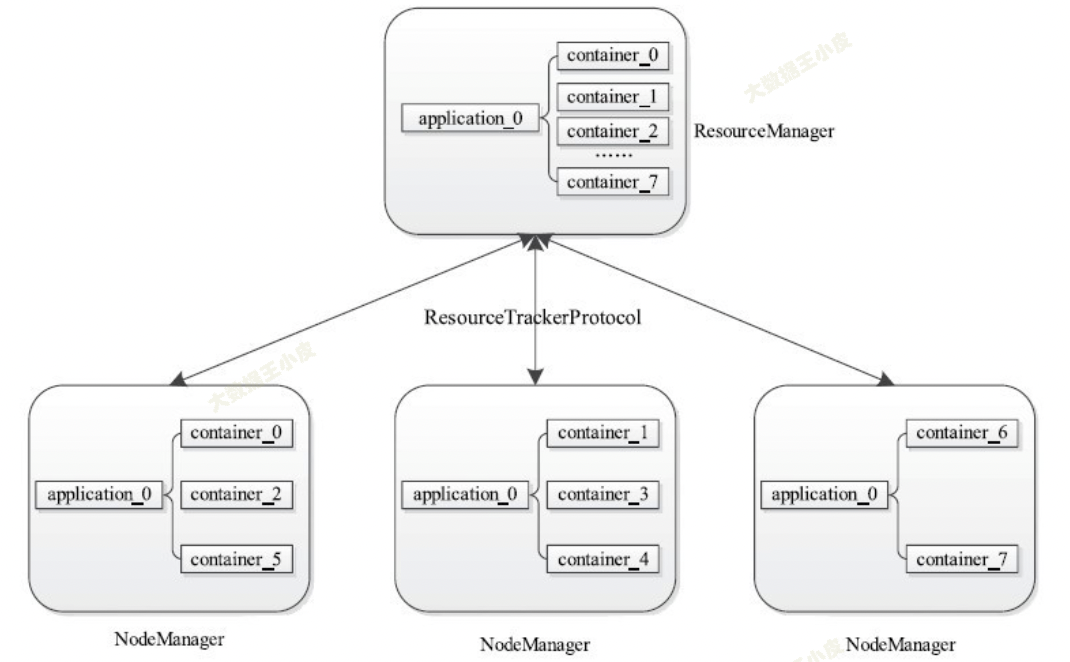【深入淺出 Yarn 架構與實現】6-4 Container 生命週期原始碼分析
本文將深入探討 AM 向 RM 申請並獲得 Container 資源後,在 NM 節點上如何啟動和清理 Container。將詳細分析整個過程的原始碼實現。
一、Container 生命週期介紹
Container 的啟動由 ApplicationMaster 通過呼叫 RPC 函數 ContainerManagementProtocol#startContainers() 發起請求,NM 中的 ContainerManagerImpl 元件負責接收並處理該函數發來的請求。
Container 啟動過程主要分為四個階段:通知 NM 啟動 Container、資源在地化、啟動並執行 Container、資源清理。

資源在地化:
主要是指分散式快取機制完成的工作(詳見上一篇《6-3 NodeManager 分散式快取》)。
功能包括初始化各種服務元件、建立工作目錄、從 HDFS 下載執行所需的各種資源(比如文字檔案、JAR 包、可執行檔案)等。
Container 啟動:
由 ContainerLauncher 服務完成,該服務將進一步呼叫插拔式元件 ContainerExecutor。Yarn 中提供了三種 ContainerExecutor 實現,分別為 DefaultContainerExecutor、LinuxContainerExecutor、DockerContainerExecutor。
資源清理:
是資源在地化的逆過程,它負責清理各類資源,均由 ResourceLocalizationService 服務完成。
二、Container 生命週期原始碼分析
一)AM 通知 NM 啟動 Container
主要流程如下:

AM AMRMClientAsyncImpl 通過 RPC 函數 ApplicationMaster#allocate() 週期性向 RM 申請資源,並將申請到的資源儲存在阻塞佇列 responseQueue 中。
(下面僅擷取重要邏輯的原始碼)
private class HeartbeatThread extends Thread {
public void run() {
while (true) {
AllocateResponse response = null;
try {
// 發心跳。發給 RM 當前的進度,從 RM 領取分配的 Container 及其他資訊。
response = client.allocate(progress);
}
// 將 RM 通過心跳返回的資訊放到阻塞佇列 responseQueue 中,等待處理
responseQueue.put(response);
跟蹤 responseQueue,其在 CallbackHandlerThread 進行取出,處理分配到的 Container。
private class CallbackHandlerThread extends Thread {
public void run() {
while (true) {
try {
AllocateResponse response;
try {
// 從 responseQueue 取出資源,對應心跳執行緒中 responseQueue.put(response)
response = responseQueue.take();
}
// 重點:處理分配到的 Container
List<Container> allocated = response.getAllocatedContainers();
if (!allocated.isEmpty()) {
// 到 ApplicationMaster#onContainersAllocated() 處理
handler.onContainersAllocated(allocated);
}
ApplicationMaster#onContainersAllocated() 會對分配出來的 Container 資源進行處理。
public void onContainersAllocated(List<Container> allocatedContainers) {
for (Container allocatedContainer : allocatedContainers) {
// 建立執行 Container 的 LaunchContainerRunnable 執行緒
Thread launchThread = createLaunchContainerThread(allocatedContainer,
yarnShellId);
// launch and start the container on a separate thread to keep
// the main thread unblocked
// as all containers may not be allocated at one go.
launchThreads.add(launchThread);
launchedContainers.add(allocatedContainer.getId());
// 啟動 LaunchContainerRunnable 執行緒
launchThread.start();
}
}
launchThread 是內部類 LaunchContainerRunnable 的範例,關注其 run() 方法幹了啥,主要兩件事:
- 構建 Container 的啟動指令碼
- 呼叫
NMClientAsync#startContainerAsync()api 介面傳送ContainerEventType.START_CONTAINER事件
// 1. 構建 Container 的啟動指令碼(省略了構建的細節)
ContainerLaunchContext ctx = ContainerLaunchContext.newInstance(
localResources, myShellEnv, commands, null, allTokens.duplicate(),
null);
containerListener.addContainer(container.getId(), container);
// 2. 重點:通過 NMClientAsync api 傳送 ContainerEventType.START_CONTAINER 事件
nmClientAsync.startContainerAsync(container, ctx);
後續就是處理這個事件,並呼叫 NM RPC 函數啟動 container 的過程,具體如下:
- 放到
BlockingQueue<ContainerEvent> events中 NMClientAsyncImpl的eventDispatcherThread會不斷處理events中的事件START_CONTAINER事件對應的狀態機處理類是StartContainerTransition- 其中執行
container.nmClientAsync.getClient().startContainer() - 這裡呼叫 NM RPC
**ContainerManagementProtocol#startContainers()**通知 NM 啟動 Container。
// yarn/client/api/impl/NMClientImpl.java
public Map<String, ByteBuffer> startContainer(
Container container, ContainerLaunchContext containerLaunchContext)
throws YarnException, IOException {
// 獲取 RPC 代理(stub)
proxy =
cmProxy.getProxy(container.getNodeId().toString(),
container.getId());
// 重點:獲取到 RPC 呼叫協定 ContainerManagementProtocol,並通過 RPC 函數 startContainers 啟動 Container
StartContainersResponse response =
proxy
.getContainerManagementProtocol().startContainers(allRequests);
至此,AM 與 NM 的互動流程已實現,通過 RPC 函數 ContainerManagementProtocol#startContainers() 來啟動 Container。後面我們將繼續在 NM 端看是如何處理這個 RPC 請求的。
二)Container 資源在地化
在 NM 端處理上述 RPC 請求的是:yarn/server/nodemanager/containermanager/ContainerManagerImpl#startContainers。
主要完成兩個事情:
- 應用程式初始化工作(該 Container 是 AM 傳送到該節點的第一個 Container)
- Container 在地化工作(非第一個 Container,會嘗試下載前面 Container 還未開始下載的檔案,以加快檔案下載速度)

1、程式初始化操作
裡面會先做一些許可權檢查、初始化等,然後呼叫函數 startContainerInternal(),我們重點關注這裡面的邏輯。
// org/apache/hadoop/yarn/server/nodemanager/containermanager/ContainerManagerImpl.java
private void startContainerInternal(NMTokenIdentifier nmTokenIdentifier,
ContainerTokenIdentifier containerTokenIdentifier,
StartContainerRequest request) throws YarnException, IOException {
// 省略 Token 認證及 ContainerLaunchContext上下文初始化
// 真正處理邏輯
this.readLock.lock();
try {
if (!serviceStopped) {
// Create the application
Application application =
new ApplicationImpl(dispatcher, user, applicationID, credentials, context);
// 應用程式的初始化,供後續 container 使用,這個邏輯只呼叫一次,通常由來自 ApplicationMaster 的第一個 container 完成
if (null == context.getApplications().putIfAbsent(applicationID,
application)) {
// 1. 傳送事件 ApplicationEventType.INIT_APPLICATION(資源在地化)
dispatcher.getEventHandler().handle(
new ApplicationInitEvent(applicationID, appAcls,
logAggregationContext));
}
this.context.getNMStateStore().storeContainer(containerId,
containerTokenIdentifier.getVersion(), request);
// 2. 傳送事件 ApplicationEventType.INIT_CONTAINER(啟動和執行 Container)
dispatcher.getEventHandler().handle(
new ApplicationContainerInitEvent(container));
this.context.getContainerTokenSecretManager().startContainerSuccessful(
containerTokenIdentifier);
傳送事件 ApplicationEventType.INIT_APPLICATION,AppInitTransition 狀態機設定 ACL 屬性後,向 LogHandler(目前有兩種實現方式,分別是 LogAggregationService 和 NonAggregatingLogHandler,這裡以 LogAggregationService 服務為例)傳送事件 LogHandlerEventType.APPLICATION_STARTED。
當 LogHandler 收到 ApplicationEventType.APPLICATION_LOG_HANDLING_INITED 事件後,將建立應用程式紀錄檔目錄、設定目錄許可權等。然後向 ApplicationImpl 傳送一個 ApplicationEventType.APPLICATION_LOG_HANDLING_INITED 事件。
// yarn/server/nodemanager/containermanager/logaggregation/LogAggregationService.java
case APPLICATION_STARTED:
LogHandlerAppStartedEvent appStartEvent =
(LogHandlerAppStartedEvent) event;
initApp(appStartEvent.getApplicationId(), appStartEvent.getUser(),
appStartEvent.getCredentials(),
appStartEvent.getApplicationAcls(),
appStartEvent.getLogAggregationContext());
// initApp()
private void initApp(final ApplicationId appId, String user,
Credentials credentials, Map<ApplicationAccessType, String> appAcls,
LogAggregationContext logAggregationContext) {
ApplicationEvent eventResponse;
try {
verifyAndCreateRemoteLogDir(getConfig());
initAppAggregator(appId, user, credentials, appAcls,
logAggregationContext);
// 傳送事件
eventResponse = new ApplicationEvent(appId,
ApplicationEventType.APPLICATION_LOG_HANDLING_INITED);
} catch (YarnRuntimeException e) {
LOG.warn("Application failed to init aggregation", e);
eventResponse = new ApplicationEvent(appId,
ApplicationEventType.APPLICATION_LOG_HANDLING_FAILED);
}
this.dispatcher.getEventHandler().handle(eventResponse);
}
ApplicationImpl 收到 ApplicationEventType.APPLICATION_LOG_HANDLING_INITED 事件後,直接向 ResourceLocalizationService 傳送 LocalizationEventType.INIT_APPLICATION_RESOURCES 事件,此時 ApplicationImpl 仍處於 INITING 狀態。
.addTransition(ApplicationState.INITING, ApplicationState.INITING,
ApplicationEventType.APPLICATION_LOG_HANDLING_INITED,
ResourceLocalizationService 收到事件請求時會建立一個 LocalResourcesTrackerImpl 物件,為接下來資源下載做準備,並向 ApplicationImpl 傳送事件 ApplicationEventType.APPLICATION_INITED。
// yarn/server/nodemanager/containermanager/localizer/ResourceLocalizationService.java
private void handleInitApplicationResources(Application app) {
// 0) Create application tracking structs
String userName = app.getUser();
// 建立 LocalResourcesTrackerImpl 物件,為接下來的資源下載做準備
privateRsrc.putIfAbsent(userName, new LocalResourcesTrackerImpl(userName,
null, dispatcher, true, super.getConfig(), stateStore, dirsHandler));
String appIdStr = app.getAppId().toString();
appRsrc.putIfAbsent(appIdStr, new LocalResourcesTrackerImpl(app.getUser(),
app.getAppId(), dispatcher, false, super.getConfig(), stateStore,
dirsHandler));
// 1) Signal container init
//
// This is handled by the ApplicationImpl state machine and allows
// containers to proceed with launching.
// 向 ApplicationImpl 傳送 ApplicationEventType.APPLICATION_INITED 事件
dispatcher.getEventHandler().handle(new ApplicationInitedEvent(
app.getAppId()));
}
ApplicationImpl 收到 ApplicationEventType.APPLICATION_INITED 事件後,依次向該應用程式已經保持的所有 Container 傳送一個 INIT_CONTAINER 事件以通知它們進行初始化。此時,ApplicationImpl 執行狀態由 INITING 轉換為 RUNNING。
2、完成 Container 在地化工作
之後的一些處理邏輯:
ContainerImpl收到 INIT_CONTAINER 事件後,先向附屬服務AuxServices傳送APPLICATION_INIT事件,以通知它有新的應用程式 Container 啟動,然後從ContainerLaunchContext中獲取各類可見性資源,並儲存到ContainerImpl中特定的資料結構中,之後向ResourceLocalizationService傳送LocalizationEventType.INIT_CONTAINER_RESOURCES事件,此時ContainerImpl執行狀態已由 NEW 轉換為 LOCALIZING。ResourceLocalizationService收到LocalizationEventType.INIT_CONTAINER_RESOURCES事件後,依次將 Container 所需的資源封裝成一個 REQUEST 事件,傳送給對應的資源狀態追蹤器LocalResourcesTrackerImpl。LocalResourcesTrackerImpl收到 REQUEST 事件後,將為對應的資源建立一個狀態機物件LocalizeResource以跟蹤資源的生命週期,並將 REQUEST 事件進一步傳送給LocalizedResource。LocalizedResource收到 REQUEST 事件後,將待下載資源資訊通過LocalizerEventType.REQUEST_RESOURCE_LOCALIZATION事件傳送給資源下載服務ResourceLocalizationService,之後LocalizedResource狀態由 NEW 轉換為 DOWNLOADING。
【這裡是重點,對應的下載邏輯】
ResourceLocalizationService 收到 LocalizerEventType.REQUEST_RESOURCE_LOCALIZATION 事件後,將交給 LocalizerTracker(ResourceLocalizationService 的內部類) 服務處理。
- 如果是 PUBLIC 資源,則統一交給 PublicLocalizer 處理。
- 如果該 Container 未建立 LocalizerRunner 執行緒,則建立一個。
- 然後新增到該執行緒的下載佇列中。
該執行緒會呼叫 ContainerExecutor#startLocalizer() 函數下載資源,該函數通過協定 LocalizationProtocol 與 ResourceLocalizationService 通訊,以順序獲取待下載資源位置下載。待資源下載完成後,向 LocalizedResource 傳送一個 LOCALIZED 事件。
public void handle(LocalizerEvent event) {
String locId = event.getLocalizerId();
switch (event.getType()) {
case REQUEST_RESOURCE_LOCALIZATION:
// 0) find running localizer or start new thread
LocalizerResourceRequestEvent req =
(LocalizerResourceRequestEvent)event;
switch (req.getVisibility()) {
case PUBLIC:
// 如果是 PUBLIC 資源,則統一交給 PublicLocalizer 處理
publicLocalizer.addResource(req);
break;
case PRIVATE:
case APPLICATION:
// 檢查是否已經為該 Container 建立了 LocalizerRunner 執行緒,
// 如果沒有,則建立一個,
// 然後新增到該執行緒的下載佇列中,該執行緒會呼叫 ContainerExecutor#startLocalizer() 函數下載資源
synchronized (privLocalizers) {
LocalizerRunner localizer = privLocalizers.get(locId);
if (null == localizer) {
LOG.info("Created localizer for " + locId);
localizer = new LocalizerRunner(req.getContext(), locId);
privLocalizers.put(locId, localizer);
localizer.start();
}
// 1) propagate event
localizer.addResource(req);
}
break;
}
break;
}
}
LocalizedResource 收到 LOCALIZED 事件後,會向 ContainerImpl 傳送一個 ContainerEventType.RESOURCE_LOCALIZED 事件,並且將狀態從 DOWNLOADING 轉換為 LOCALIZED。ContainerImpl 收到事件後,會檢查所依賴的資源是否全部下載完畢,如果下載完成則向 ContainersLauncher 服務傳送一個 LAUNCH_CONTAINER 事件,以啟動對應 Container。
資源在地化過程可概括為:
- 在 NM 上,同一個應用程式的所有
ContainerImpl非同步並行向資源下載服務ResourceLocalizationService傳送待下載的資源。 ResourceLocalizationService下載完一類資源後,將通知依賴該資源的所有Container- 一旦一個 Container 依賴的資源已經全部下載完成,則該Container進入執行階段。
三)啟動和執行 Container
我們再回到 ContainerManagerImpl,INIT_APPLICATION 事件的處理完成了「資源在地化」的操作,後續傳送 INIT_CONTAINER 事件,是本節「啟動和執行 Container」要分析的部分。
// org/apache/hadoop/yarn/server/nodemanager/containermanager/ContainerManagerImpl.java
private void startContainerInternal(NMTokenIdentifier nmTokenIdentifier,
ContainerTokenIdentifier containerTokenIdentifier,
StartContainerRequest request) throws YarnException, IOException {
// 1. 傳送事件 ApplicationEventType.INIT_APPLICATION(資源在地化)
dispatcher.getEventHandler().handle(
new ApplicationInitEvent(applicationID, appAcls,
logAggregationContext));
// 2. 傳送事件 ApplicationEventType.INIT_CONTAINER(啟動和執行 Container)
dispatcher.getEventHandler().handle(
new ApplicationContainerInitEvent(container));
傳送事件 ApplicationEventType.INIT_CONTAINER,由 ApplicationImpl 處理
.addTransition(ApplicationState.NEW, ApplicationState.NEW,
ApplicationEventType.INIT_CONTAINER,
INIT_CONTAINER_TRANSITION)
- 傳送
ContainerEventType.INIT_CONTAINER事件 - 在
ContainerImpl.RequestResourcesTransition中處理 - 其中重點邏輯是啟動 Container
container.sendLaunchEvent() - 又傳送
ContainersLauncherEventType.LAUNCH_CONTAINER事件
這裡探究下 LAUNCH_CONTAINER 事件的處理流程。從這裡去跟蹤的時候會發現,沒有狀態機註冊這個事件,找不到對應的處理邏輯,那麼這個事件是如何被處理的呢?
我們去找到這個事件型別註冊的地方:
// yarn/server/nodemanager/containermanager/ContainerManagerImpl.java
dispatcher.register(ContainersLauncherEventType.class, containersLauncher);
其註冊的事件處理器為 ContainersLauncher 類,在這裡我們找到了 handle() 方法,裡面對事件進行處理。
// yarn/server/nodemanager/containermanager/launcher/ContainersLauncher.java
public void handle(ContainersLauncherEvent event) {
// TODO: ContainersLauncher launches containers one by one!!
Container container = event.getContainer();
ContainerId containerId = container.getContainerId();
switch (event.getType()) {
case LAUNCH_CONTAINER:
Application app =
context.getApplications().get(
containerId.getApplicationAttemptId().getApplicationId());
// LAUNCH_CONTAINER 事件的處理邏輯,建立 ContainerLaunch 執行緒並啟動執行緒
ContainerLaunch launch =
new ContainerLaunch(context, getConfig(), dispatcher, exec, app,
event.getContainer(), dirsHandler, containerManager);
// 提交到執行緒池
containerLauncher.submit(launch);
// 將其加入到執行的 Container 資料結構 running 中
running.put(containerId, launch);
break;
ContainerLaunch 類繼承自 Callable 類,通過 submit() 提交到執行緒池中,之後呼叫 Callable 類的實現方法 call() 來真正執行執行緒,主要邏輯如下:
- 準備 Container 的執行環境
- shell啟動指令碼的封裝與拓展(新增自定義指令碼)
- 建立本地工作目錄
- 設定token的儲存路徑
- 更新 Container 狀態,從 LOCALIZED 轉換為 RUNNING
- 傳送
CONTAINER_LAUNCHED事件 - 傳送
START_MONITORING_CONTAINER事件,啟動對該 container 的資源監控
- 傳送
- 呼叫 ContainerExecutor 物件在 NM 節點上啟動 Container
- ContainerExecutor 由使用者指定(
DefaultContainerExecutor,LinuxContainerExecutor,DockerContainerExecutor) - 通過具體的 ContainerExecutor 在 NM 上啟動 Container
- ContainerExecutor 由使用者指定(
// yarn/server/nodemanager/containermanager/launcher/ContainerLaunch.java
public Integer call() {
// 啟動 Container 前的準備工作:
// 1.shell啟動指令碼的封裝與拓展(新增自定義指令碼)
// 2.建立本地工作目錄
// 3.設定token的儲存路徑
final ContainerLaunchContext launchContext = container.getLaunchContext();
// 傳送 CONTAINER_LAUNCHED 事件 & START_MONITORING_CONTAINER 事件
dispatcher.getEventHandler().handle(new ContainerEvent(
containerID,
ContainerEventType.CONTAINER_LAUNCHED));
context.getNMStateStore().storeContainerLaunched(containerID);
// 重點:呼叫 ContainerExecutor 物件啟動 Container
// ContainerExecutor 由使用者指定(DefaultContainerExecutor, LinuxContainerExecutor, DockerContainerExecutor)
exec.activateContainer(containerID, pidFilePath);
ret = exec.launchContainer(new ContainerStartContext.Builder()
.setContainer(container)
.setLocalizedResources(localResources)
.setNmPrivateContainerScriptPath(nmPrivateContainerScriptPath)
.setNmPrivateTokensPath(nmPrivateTokensPath)
.setUser(user)
.setAppId(appIdStr)
.setContainerWorkDir(containerWorkDir)
.setLocalDirs(localDirs)
.setLogDirs(logDirs)
.build());
// 完成傳送 CONTAINER_EXITED_WITH_SUCCESS 事件
LOG.info("Container " + containerIdStr + " succeeded ");
dispatcher.getEventHandler().handle(
new ContainerEvent(containerID,
ContainerEventType.CONTAINER_EXITED_WITH_SUCCESS));
同時,由於 ContainerExecutor#launchContainer 函數是阻塞式的,因此只有當指令碼執行完成後才退出,這使得 ContainerLauncher 可在第一時間知道 Container 完成時間,之後向 ContainerImpl 傳送一個 CONTAINER_EXITED_WITH_SUCCESS 事件,此時 ContainerImpl 狀態由 RUNNING 轉換為 EXITED_WITH_SUCCESS。
至此,一個 Container 執行完成,接下來將進入該 Container 的資源清理階段。
四)Container 資源清理
當 Container 執行完成後(成功或失敗),會執行資源清理工作。主要清理下面兩類資源:
ResourceLocalizationService:從 HDFS 下載到原生的資料檔案ContainerExecutor:為 Container 建立私有工作目錄,並儲存一些臨時檔案(比如 Container 程序 pid 檔案)
在上一步 call() 方法最後,Container 執行完成時,會傳送 CONTAINER_EXITED_WITH_SUCCESS 事件。
// yarn/server/nodemanager/containermanager/container/ContainerImpl.java
.addTransition(ContainerState.RUNNING,
ContainerState.EXITED_WITH_SUCCESS,
ContainerEventType.CONTAINER_EXITED_WITH_SUCCESS,
new ExitedWithSuccessTransition(true))
// ------------------------
static class ExitedWithSuccessTransition extends ContainerTransition {
public void transition(ContainerImpl container, ContainerEvent event) {
// Set exit code to 0 on success
container.exitCode = 0;
if (clCleanupRequired) {
// 向 ContainerLauncher 傳送 ContainersLauncherEventType.CLEANUP_CONTAINER 清理事件
container.dispatcher.getEventHandler().handle(
new ContainersLauncherEvent(container,
ContainersLauncherEventType.CLEANUP_CONTAINER));
}
// 向 ResourceLocalizationService 傳送 LocalizationEventType.CLEANUP_CONTAINER_RESOURCES 清理事件
container.cleanup();
}
}
1、ContainerLauncher 清理臨時目錄
處理 ContainersLauncherEventType.CLEANUP_CONTAINER 事件。
處理邏輯會進入到 ContainersLauncher 的 handle() 方法,將 Container 從正在執行的 Container 列表中移除,並呼叫 ContainerLaunch#cleanupContainer() 方法清除 Container 佔用的臨時目錄。
case CLEANUP_CONTAINER:
// 將 Container 從正在執行 Container 列表中移除
ContainerLaunch launcher = running.remove(containerId);
if (launcher == null) {
// Container not launched. So nothing needs to be done.
return;
}
// Cleanup a container whether it is running/killed/completed, so that
// no sub-processes are alive.
try {
// 清理 Container 佔用的臨時目錄(kill程序,刪除 pid 檔案等)
launcher.cleanupContainer();
} catch (IOException e) {
LOG.warn("Got exception while cleaning container " + containerId
+ ". Ignoring.");
}
break;
2、ResourceLocalizationService 清理使用者工作目錄和私有目錄
處理 LocalizationEventType.CLEANUP_CONTAINER_RESOURCES 事件。
case CLEANUP_CONTAINER_RESOURCES:
handleCleanupContainerResources((ContainerLocalizationCleanupEvent)event);
break;
handleCleanupContainerResources() 將會刪除
- 使用者工作的資料(即從 HDFS 下載的資料)
${yarn.nodemanager.local-dirs}/usercache/<user>/appcache/${appid}/${containerid} - 私有目錄資料
${yarn.nodemanager.local-dirs}/nmPrivate/${appid}/${containerid}(執行指令碼、token檔案、pid檔案)- 其中 執行指令碼、token 會在 Container 啟動時複製到 「使用者工作的資料」目錄中
這兩個目標都存放了 Tokens 檔案和 Shell 執行指令碼。
3、保留的目錄
注意:{yarn.nodemanager.local-dirs}/usercache/{appid}/output 並不會刪除,計算任務之間有依賴關係,因此 NodeManager 不能在 Container 執行完成之後立刻清理它佔用的所有資源,尤其是產生的中間資料,而只有當所有 Container 執行完成之後,才能夠全部清空這些資源。
當一個應用程式執行結束時,需要由它廣播給各個NodeManager,再進一步由NodeManager清理應用程式佔用的所有資源,包括產生的中間資料。

到這裡 container 清理工作完成。
三、小結
本節深入原始碼介紹了 Container 生命週期的整體流程。從通知 NM 啟動 Container、資源在地化、啟動 Container、資源清理四個方面進行了介紹。
參考文章:
《Hadoop技術內幕:深入解析YARN架構設計與實現原理》
Yarn Container啟動流程原始碼分析
NodeManager詳細元件及功能
深入解析yarn架構設計與技術實現-NodeManager2
hadoop-yarn-src-read - 一些 yarn 學習筆記